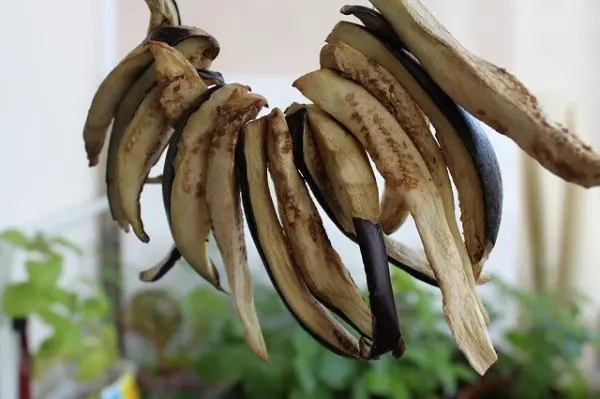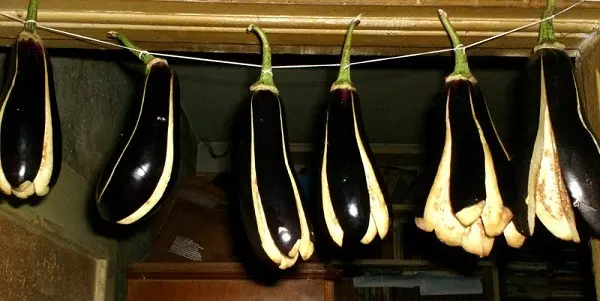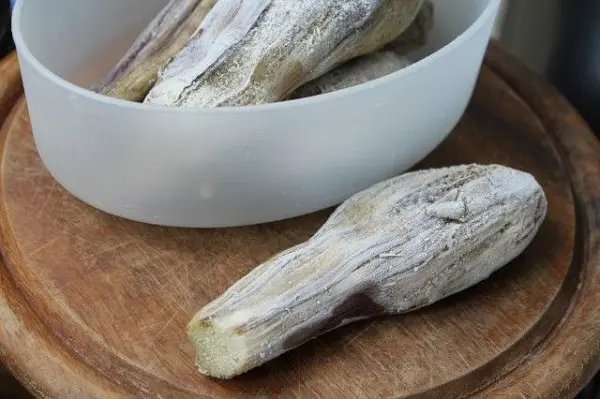Contents
Many of us have repeatedly heard about the excellent taste of eggplant, about their vitamin benefits and multiple recipes for dishes from this amazing vegetable, which almost no one will refuse. But the approach of cold weather makes many hostesses seriously think about how to save eggplants in the winter season. To do this, you should know a little about the features of this vegetable and the methods of its winter storage at home.
Selection and preparation of fruits for storage
Before you start harvesting eggplant for the winter, it is first of all important to determine the quality of vegetables that will be subject to long-term storage. They must be fresh. There are certain rules, thanks to which you can select suitable fruits that will not deteriorate for the first time during the winter months.
So, it’s important to remember the following:
- It is necessary to choose varieties suitable for laying: “Robin Hood”, “Balagur”, “Vakula”. These are large-fruited eggplants, with a fairly thick crust. Also for storage for the winter, you can use varieties such as Sperm Whale, Torpedo, F1 Bard, F1 Goliath. They can confidently lie for 3 to 5 months, throughout the winter, but only if all the necessary conditions are exactly met.
- You should decide on the time of collection. This must be done before the first autumn cold snap sets in. Otherwise, the crop may be spoiled by rot. Accordingly, such fruits are clearly not suitable for lying.
- The crop should be harvested exclusively in dry weather. This will not only save your strength, but also protect the crop from fungal infections. After harvesting, the fruits will need to be dried, preferably not in the sun, since solanine is produced under the influence of ultraviolet rays, which is harmful to human health. If you have harvested vegetables at a high level of humidity, then they cannot be immediately laid for the winter, they will begin to rot. Therefore, provide a number of additional measures for drying vegetables.
- Selected fruits for maturation must be ripe. At the same time, overripe fruits are completely unsuitable for long-term storage. To learn about the ripeness of a vegetable, you can lightly poke it with your fingernail. If the peel is difficult to damage, then it can be taken for storage.
- On the peel of a ripened vegetable, there should be no significant defects that can destroy not only this eggplant, but also other specimens located in the storage.
- When collecting vegetables from the garden, the fetus should have a leg 2 to 3 cm long. This will not allow the fruit to dry out quickly, and the infection will not be able to harm it over the winter. In addition, by the leg you can find out about the condition of the fetus.
- In no case do not wash the vegetables that you put aside for storage! To clean and remove the earth from them, you just need to shake off the vegetable and wipe it with a cloth.
- It should be remembered that the optimum storage temperature is +3-5°C, maximum +10°C. The level of air humidity should not exceed 75-85%. Try to create just such conditions in your storage to ensure a long wintering of your eggplants. It is noteworthy that these recommendations are important to consider only when storing eggplant in a cellar or a dark, cool place. For other storage methods, these conditions are not necessary at all, since eggplants will be subject to subsequent processing.
Ways of storage

After appropriate preparation of vegetables for the storage process, it is important to decide in which way they will be stored all winter. There are some of the most common ways to preserve eggplant during the winter period at home.
In a cellar/dark place
In order to save the harvest for a long time in the cellar, basement or pantries, eggplants should be placed in cardboard boxes, and they should not be folded in bulk, but carefully packaged individually and separated from each other with a thick paper partition. Layers in such a box should be from one to two or three. It is not worth putting a lot on top of each other, because the lack of air circulation will lead to damage or spoilage of vegetables. Instead of paper, you can use straw or hay, but in this case, the eggplants are laid out in a single layer on a straw bed and covered with burlap for about two weeks to isolate the vegetables from excessive weathering and exposure to humid air.

After a two-week period, the eggplants are sorted. For further storage, only whole and undamaged by external factors vegetables are left. After sorting, the eggplants are again placed on a dry bed of straw and remain in storage all winter. Also, another well-known method for storing eggplant in the basement is to fill them with wood ash in deep wooden boxes, followed by keeping at a temperature of +7 ° C. The original way to store eggplant in basements or dark places is hanging. To do this, at home use a regular grid. It is stretched at some distance from the floor, and then the eggplants are laid out in one layer. To avoid souring and rotting vegetables, the room must be ventilated with a mandatory temperature of +3 °C.
Dried

In addition to fresh storage of eggplant for the winter, their drying is also practiced. As a rule, vegetables are dried in two ways: naturally or artificially. If you dry eggplants in the open air, then you must take into account that this process can last for several days. To dry the fruits in a natural way, you need to prepare them in advance – wash them from dirt and dust. Eggplants can be dried whole or cut into several pieces. Having decided on the type of drying, you need to lay out the prepared material on a baking sheet or oilcloth with a small distance from each other and place the eggplants in the open air, the main thing is not to get direct sunlight. In addition, you can cut the eggplant into rings and, stringing them on a thread or fishing line, hang them in a well-ventilated room or on the street.
The artificial method involves drying vegetables in the oven. Its advantages are that it is faster and more practical. It is also less dangerous for human health, since it not only guarantees the absence of solanine production in fruits, but also eliminates the infection of drying by the larvae of various insects, including flies that land on eggplants dried on the street. Drying eggplant in the oven is quite simple. They must be pre-prepared and chopped into medium-sized pieces. They must be laid out on a baking sheet and placed in the oven for about 6 hours, keeping at a temperature of no more than 50 ° C. After the specified time, the drying must be removed from the oven and allowed to cool for 1 hour. If moisture remains in the vegetables, and the pieces are not dried, but dried, then the process should be repeated, reducing the eggplant stay in the oven to 1,5-2 hours.
Video “Dry eggplant”
This video shows how to dry eggplant for the winter.
Freezing
This is the easiest way to store eggplant. It requires a minimum of effort and cost. In addition, frozen vegetables do not lose their beneficial properties than when they are dried. The process of preparing eggplant for freezing is no different from preparing it for drying. The only difference is the size of the pieces into which the eggplant can be cut. Since the vegetable does not shrink when frozen, the eggplant can be cut into small cubes, strips, rings, etc.

To get rid of the bitterness of raw eggplant before freezing, sprinkle it with salt, wait about 20 minutes and rinse with water. Putting unsalted eggplants in the freezer, subsequently, they will taste unpleasant.
Also, to preserve the taste of frozen eggplant, after salting, you need to blanch the sliced u3bu4bpieces in boiling water and immediately lower them into cold water. All this, after a series of procedures, is laid out on a plate or tray, covered with polyethylene and placed in the freezer for XNUMX-XNUMX hours. Next, frozen eggplants are taken out of the freezer for packing, packed and put back for long-term storage.
Video “Eggplant for the winter – freezing eggplant”
The correctness of freezing eggplant for the winter is described in detail in this video.
Author: Svetlana Galitsina
Loading…









